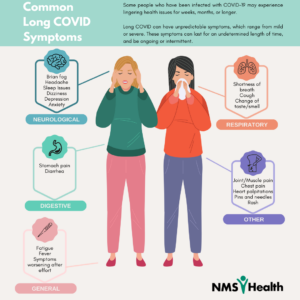Employees struggling with long COVID could be more common than you think
Throughout the COVID-19 pandemic, employers have had to deal with an ever-changing labor landscape. From closures to remote work to employee burnout and increased mental health strain, employers have had to quickly adapt to the challenges their employees faced. Even so, since 2020 a record number of employees have left their jobs. Unfortunately, the outlook for the labor market continues to be grim. More cases of COVID-19 continue as time goes on, and for some of those employees they may have unresolved health problems long after they test positive. This is now being referred to as post-COVID conditions, long-haul COVID, or long COVID. While not every person with long COVID will be unable to work, many will experience struggles with long COVID.
A new report from Brookings finds that long COVID is keeping as many as 4 million people out of work. In September 2022 there were more than 11 million US jobswhich remained vacant. It’s possible that up to one-third of current labor shortages are impacted by long COVID. The Brookings report used data from Census Bureau’s Household Pulse Survey conducted in June, which included four new questions about long COVID in hopes to better understand the condition’s prevalence.
Brookings compared the Household Pulse Survey findings with a recent study from the Federal Reserve Bank of Minneapolis which found that approximately 24% of people who had contracted COVID-19 experienced symptoms for at least three months. According to the Centers for Disease Control and Prevention, about 70% of Americans have contracted COVID-19 since the beginning of the pandemic. If 24% of COVID cases lead to long COVID, that means 34 million working-age Americans have had long COVID at some point. The study also found that 50% of respondents had recovered, leaving around 17 million working-age Americans currently living with long COVID.
With long COVID symptoms affecting so many working-age people, there is an obvious impact to employers. The Minneapolis Fed study found that 25.9% of people with long COVID have had their work hours “impacted”. A survey from the United Kingdom’s Trades Union Congress (TUC) found that 20% of people with long COVID were not working, and 16% had working hours reduced. A study published in the Lancet, found that 22% of people could not work at all due to their health, and another 45% were working reduced hours. Using these three references, Brookings states that 2 million, 3 million, and 4 million full-time equivalent workers, respectively, are out of the labor force due to long COVID. Using the midpoint of 3 million workers, that is translated to an estimated $168 billion a year in lost earnings. This number does not take into account lower productivity for employees who are still working while struggling with symptoms or serving as a caregiver to someone else with long COVID.
Symptoms of long COVID
Long COVID symptoms can be unpredictable, and each person’s experience is often unique. According to the CDC, post-COVID conditions can include a wide range of ongoing health problems which can last weeks, months, or longer. Some people may have severe, disabling symptoms that prevent them from working at all, while others with milder symptoms can maintain employment with the help of employer accommodations.
People who experience post-COVID conditions most commonly report:
General symptoms
- Tiredness or fatigue that interferes with daily life
- Symptoms that get worse after physical or mental effort (also known as “post-exertional malaise”)
- Fever
Respiratory and heart symptoms
- Difficulty breathing or shortness of breath
- Cough
- Chest pain
- Fast-beating or pounding heart (also known as heart palpitations)
Neurological symptoms
- Difficulty thinking or concentrating (sometimes referred to as “brain fog”)
- Headache
- Sleep problems
- Dizziness when you stand up (lightheadedness)
- Pins-and-needles feelings
- Change in smell or taste
- Depression or anxiety
Digestive symptoms
- Diarrhea
- Stomach pain
Other symptoms
- Joint or muscle pain
- Rash
- Changes in menstrual cycles
What the ADA has to say about long COVID
In July of 2021, the Department of Health and Human Services and the Department of Justice provided guidance related to long COVID. They confirmed that under the Americans with Disabilities Act (ADA) and the Rehabilitation Act, a person with long COVID has a disability if their condition or any of its symptoms is a “physical or mental” impairment that “substantially limits” one or more major life activities such as eating, sleeping, concentrating, communicating, and working, amongst others.
According to HHS, a physical impairment includes any physiological disorder or condition affecting one or more body systems, including, among others, the neurological, respiratory, cardiovascular, and circulatory systems. A mental impairment includes any mental or psychological disorder, such as an emotional or mental illness. The term “substantially limits” can be construed broadly under the law. The disability does not have to be permanent or long-term. Even if the impairment is intermittent, it is considered a disability if it would substantially limit a major life activity when the impairment is active.
While not every case of long COVID will be classified as a disability, for those whose symptoms qualify them as disabled, they are entitled to the same protections as any other person with a disability. Title I of the ADA covers employers who employ 15 or more people, including state and local governments. It also applies to employment agencies and labor organizations. All nondiscrimination standards under Title I of the ADA also apply to federal agencies under Section 501 of the Rehabilitation Act. Under the ADA, employees are entitled to reasonable accommodations. This can look like modified work schedules, providing additional equipment or devices, or adjusting of modifying examinations, training materials, or policies.
Supporting employees’ struggles with long COVID
The first step for employers is recognizing that long COVID is a real condition that has a complex and unique set of symptoms. Although each employee may present with different symptoms and needs, it does not mean that the employee is not ill. Employees’ struggles with long COVID can present in a variety of ways. Educating your management teams on how long COVID can present itself is important in order to sympathize with what employees are going through.
Structuring an environment, not only for management but for all employees to bring up issues openly is imperative to supporting those with long COVID. Disclosing information about a disability can be intimidating in any situation but especially if workers think their job is on the line. Letting employees know what accommodations are available, and that you are ADA compliant may foster a sense of safety and transparency amongst current team members.
It is also important that both current employees and potential employees are treated with respect if they choose to disclose their long COVID or ask for accommodations. By providing effective accommodations when needed, employers can support and retain their workers. Some employees may choose to disclose their long COVID during the hiring process. It benefits everyone if the employer can promptly confirm that they have understood the disclosure and any requests for accommodations. Employers should strive to accommodate their employees as much as possible, dependent on the symptoms they’re exhibiting. Once a request for accommodation has been made, the employer should engage with the employee in an interactive process in which the employer and employee develop their accommodation.
Additionally, embracing flexibility will benefit not only employees who are sick but also the entire team. Employees who are struggling with long COVID may need to restructure their hours, transition to different job responsibilities, or utilize remote options to maintain productivity levels. These are all options that can be offered to the staff to keep them feeling safe and productive as well. Many long COVID patients find that remote work can be a better option for managing symptoms than going into an office and for others, remote work may feel safer if they are worried about infection or reinfection. When flexibility is built into existing workplace policies, employees who are experiencing a disability have less of need to disclose their health history and request additional accommodations.
Currently, 27% of private sector workers in the U.S. do not have access to any form of paid sick leave. While congress has not expanded sick leave requirements, it does not mean that you cannot adapt your PTO policies. Expanding your company’s PTO programs can provide added flexibility for employees. When workers have access to sick leave, they are less likely to come into the office sick and spread illnesses like COVID-19.
FAQ
The Labor Department has released it’s for guide for employers. Some of the following FAQs are included within their guide.
Q: Do we need to provide accommodations for an employee who will only need it temporarily?
Yes. For any employee with a disability as defined under the ADA, reasonable accommodations for any limitations related to the disability must be provided even if it is temporary. Once it is no longer needed, the accommodation can simply be removed.
Q: How flexible do our workplace flexibility provisions have to be for an employee with long COVID?
Any accommodation that is provided under the ADA must be done so unless it causes undue hardship. If you are providing flexible schedules for all employees as part of a workplace policy, you can be as flexible as you choose and then provide additional accommodations on a case-by-case basis for employees with disabilities.
Q: What if my employee cannot provide an official long COVID diagnosis?
It may be difficult for some employees to receive an official long COVID diagnosis. The condition is relatively new and wildly variable. Some employees may even develop long COVID after being asymptomatic during their COVID-19 infection. The Labor Department is urging employers not to rule out accommodations for employees who don’t get an official long COVID diagnosis.
“Rather than determining whether an employee has a disability, your focus should be on the employee’s limitations and whether there are effective accommodations that would enable the employee to perform essential job functions.”
An official diagnosis may not be needed to move forward with providing accommodations if their impairment is limiting their ability to work.
Q: How do I support an employee who requests time off for long COVID?
Employee may have a few options when it comes to time off requests. They may be eligible for intermittent leave under the Family and Medical leave act, use accrued paid leave, or be allowed to use intermittent leave as an ADA-related accommodation.
Q: Am I obligated to support employees who are caregivers for someone with long COVID?
The Equal Employment Opportunity Commission (EEOC) released new guidance about caregiver protections in March 2022. Caregiver discrimination is unlawful if it is based on an applicant’s or employee’s association with an individual with a disability.
“As a result, applicants, and employees with caregiving responsibilities for an individual with a disability, which may include some individuals with COVID-19 or lingering symptoms, are protected from discrimination based on their association with the care recipient. For example, it would be unlawful under the ADA (or Rehabilitation Act) for an employer to refuse an employee’s request for unpaid leave to care for a parent with long COVID that is a disability under those laws, while approving other employees’ requests for unpaid leave to handle other personal responsibilities. Depending on the circumstances, this also may violate the Family and Medical Leave Act enforced by the Department of Labor, or similar state or local laws.”



